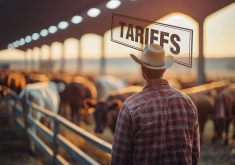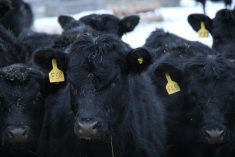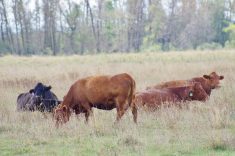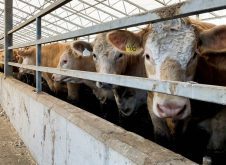If you’ve completed an environmental farm plan, you’ll feel fairly comfortable being verified as part of McDonald’s sustainable beef pilot project.
That’s the take of Elise Walker, a Milk River-area producer who was verified in June — although the process looked overwhelming at first.

“There are a lot of questions,” said Walker who, along with husband Kelly, runs an Angus cow-calf herd and does backgrounding and feeding at their farm near Milk River.
“But if you’ve done your environmental farm plan, you’ve already completed a huge self-assessment of your operation. I feel like this ties in with that. It’s not as bad as it looks.”
After months of review and tweaking, McDonald’s Canada recently released details of its criteria — called indicators — for ‘verified sustainable beef’ on the www.vsbpilot.ca website. There are roughly 30 indicators (one set for cow-calf producers and one for feeders) and each indicator comes with a ranking scale, ranging from 1 (Entry) to 5 (Excellence).
Read Also

Dennis Laycraft to be inducted into the Canadian Agricultural Hall of Fame
Dennis Laycraft, Executive Vice President of the Canadian Cattle Association, is one of this year’s inductees into the Canadian Agricultural Hall of Fame. Laycraft was nominated for his many contributions to the cattle industry.
The indicators were developed with participants and the beef sector with the understanding that the process was more about documenting what producers are already doing rather than imposing new or onerous practices.
But the rating system does encourage producers to ensure they’re employing good practices. For example, to meet the Level 3 criteria (Achievement), producers have to have an environmental farm plan and have implemented the water and soil health components. That level also requires doing rangeland health assessments and implementing workplace safety measures. It also forbids the use of electric cattle prods (unless the handler or animal is in danger) and, effective Jan. 1, 2016, requires pain control for dehorning and castration.
But Walker said the biggest challenges for her and her husband, who are both first-generation producers, was getting their heads around all of the indicators — and finding time to host the independent third-party verifier during the busy spring season.
They solved the latter problem by picking a day a couple of months in advance, knowing they wouldn’t back out no matter how busy they were. Then they each printed out a copy of the indicators and over the next month, recorded their own thoughts and observations on them.
A few days before the verifier arrived, the couple, who makes all farm decisions together, went through the indicators and compared notes.
“It was interesting to go through it because he understood some of the questions differently than I had,” she said. “He also thought of answers that I hadn’t thought of.”
It turned out the couple’s preparations were just what they needed to do.
“You get worried that you need to do a lot of work and prepare for it, but if you go through the indicators and read through them, that’s exactly how you go through your day with your verifier,” said Walker.
The verifier was friendly and easy to get along with, she said. The Walkers just showed him around their operation and answered questions during the half-day he was there. (The process typically takes four to six hours.)
“You basically cover every corner of your operation — you show him what you do (over the course of) a year,” she said. “They never compare you to another operation. They’re solely interested in how you operate.”
The process wasn’t intimidating at all, and it was just like showing an interested visitor around the ranch, said Walker.
The process will be a little smoother for anyone who has enrolled since the indicators have finalized because redundant or strangely worded indicators have been removed, she added.
The Walkers still haven’t received their scores, but now that the indicators have been finalized, producers who have gone through the process will be getting their numbers soon.
McDonald’s is looking for more producers for the pilot project, and Walker said she and her husband learned a lot from both the self-assessment and the day spent with the verifier.
“It was a positive experience,” she said.
For more information on the indicators and how to sign up, go to vsbpilot.ca.
















